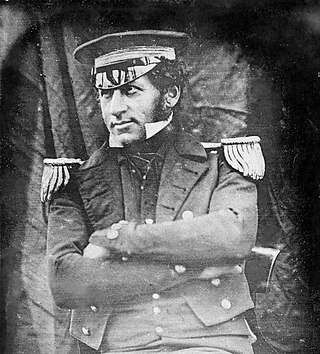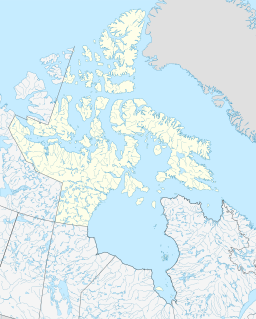
Ross Island is an island in Antarctica lying on the east side of McMurdo Sound and extending 43 nautical miles from Cape Bird on the north to Cape Armitage on the south, and a like distance from Cape Royds on the west to Cape Crozier on the east. The island is entirely volcanic. Mount Erebus, 3,795 metres (12,451 ft), near the center, is an active volcano. Mount Terror, 3,230 metres (10,600 ft), about 20 nautical miles eastward, is an extinct volcano. Mount Bird rises to 1,765 metres (5,791 ft) just south of Cape Bird. Ross Island lies within the boundary of Ross Dependency, an area of Antarctica claimed by New Zealand.

Sir John Franklin was a British Royal Navy officer and Arctic explorer. After serving in wars against Napoleonic France and the United States, he led two expeditions into the Canadian Arctic and through the islands of the Arctic Archipelago, in 1819 and 1825, and served as Lieutenant-Governor of Van Diemen's Land from 1839 to 1843. During his third and final expedition, an attempt to traverse the Northwest Passage in 1845, Franklin's ships became icebound off King William Island in what is now Nunavut, where he died in June 1847. The icebound ships were abandoned ten months later and the entire crew died from causes such as starvation, hypothermia, and scurvy.

HMS Erebus was a Hecla-class bomb vessel constructed by the Royal Navy in Pembroke dockyard, Wales, in 1826. The vessel was the second in the Royal Navy named after Erebus, the personification of darkness in Greek mythology.

Kitikmeot Region is an administrative region of Nunavut, Canada. It consists of the southern and eastern parts of Victoria Island with the adjacent part of the mainland as far as the Boothia Peninsula, together with King William Island and the southern portion of Prince of Wales Island. The regional centre is Cambridge Bay.

Gjoa Haven is an Inuit hamlet in Nunavut, above the Arctic Circle, located in the Kitikmeot Region, 1,056 km (656 mi) northeast of Yellowknife, Northwest Territories. It is the only settlement on King William Island.

HMS Terror was a specialised warship and a newly developed bomb vessel constructed for the Royal Navy in 1813. She participated in several battles of the War of 1812, including the Battle of Baltimore with the bombardment of Fort McHenry. She was converted into a polar exploration ship two decades later, and participated in George Back's Arctic expedition of 1836–1837, the successful Ross expedition to the Antarctic of 1839 to 1843, and Sir John Franklin's ill-fated attempt to force the Northwest Passage in 1845, during which she was lost with all hands along with HMS Erebus.
Beechey Island is an island located in the Arctic Archipelago of Nunavut, Canada, in Wellington Channel. It is separated from the southwest corner of Devon Island by Barrow Strait. Other features include Wellington Channel, Erebus Harbour, and Terror Bay.

Francis Rawdon Moira Crozier was an Irish officer of the Royal Navy and polar explorer who participated in six expeditions to the Arctic and Antarctic. In 1843, he became a Fellow of the Royal Society for his scientific work during his multiple expeditions. Later, he was second-in-command to Sir John Franklin and captain of HMS Terror during the Franklin expedition to discover the Northwest Passage, which ended with the loss of all 129 crewmen in mysterious circumstances.
Queen Maud Gulf lies between the northern coast of the mainland and the southeastern corner of Victoria Island in Nunavut, Canada. At its western end lies Cambridge Bay, leading to Dease Strait; to the east lies Simpson Strait; and to the north, Victoria Strait. It is home to the Queen Maud Gulf Migratory Bird Sanctuary.

Franklin's lost expedition was a failed British voyage of Arctic exploration led by Captain Sir John Franklin that departed England in 1845 aboard two ships, HMS Erebus and HMS Terror, and was assigned to traverse the last unnavigated sections of the Northwest Passage in the Canadian Arctic and to record magnetic data to help determine whether a better understanding could aid navigation. The expedition met with disaster after both ships and their crews, a total of 129 officers and men, became icebound in Victoria Strait near King William Island in what is today the Canadian territory of Nunavut. After being icebound for more than a year Erebus and Terror were abandoned in April 1848, by which point two dozen men, including Franklin, had died. The survivors, now led by Franklin's second-in-command, Francis Crozier, and Erebus's captain, James Fitzjames, set out for the Canadian mainland and disappeared, presumably having perished.
Prince Alfred Bay is a waterway in Qikiqtaaluk Region, Nunavut, Canada. It lies off the western coast of Devon Island, forming a border of the Grinnell Peninsula, in the eastern high Arctic. Like Pioneer Bay to the south, it is an arm of Wellington Channel.
O'Reilly Island is an uninhabited island in Nunavut Territory, Canada. It lies to the south of King William Island and to the west of the Klutschak and Adelaide Peninsulas, in the easternmost part of the Queen Maud Gulf.
Arctic Research Foundation (ARF) is a private, non-profit organization based in Canada. Federally incorporated in 2011, ARF works with Indigenous and Northern communities, NGOs, government, private corporations and academia to facilitate science research and community initiatives.
Terror Bay is an Arctic waterway in the Kitikmeot Region, Nunavut, Canada. It is located on the southwestern side of King William Island. The entrance to the bay is marked by Fitzjames Island on the west and Irving Island to the east. The bay opens to Queen Maud Gulf.

Graham Gore was an English officer of the Royal Navy and polar explorer who participated in two expeditions to the Arctic and a survey of the coastline of Australia aboard HMS Beagle. In 1845 he served under Sir John Franklin as First Lieutenant on the Erebus during the Franklin expedition to discover the Northwest Passage, which ended with the loss of all 129 officers and crewmen in mysterious circumstances.

The Wrecks of HMS Erebus and HMS Terror National Historic Site is a National Historic Site of Canada near King William Island in the Kitikmeot Region of Nunavut. It protects the wrecks of HMS Erebus and HMS Terror, the two ships of the last expedition of Sir John Franklin, lost in the 1840s during their search for the Northwest Passage and then re-discovered in 2014 and 2016. The site is jointly managed by Parks Canada and the local Inuit. Public access to the site is not permitted.

Nattilik Heritage Centre is a museum in Gjoa Haven, King William Island, Nunavut, Canada. It presents the history and culture of the local Inuit.
David Charles Woodman is a Canadian mariner, author, and arctic researcher. He is known for his research on Franklin's Lost Expedition, having led or participated in nine expeditions to King William Island between 1992 and 2004, searching for relics, records, and the wrecks of the ships HMS Terror and HMS Erebus, and establishing the important role of Inuit oral testimony in the search.
John Gregory was an English railway and naval engineer. He served as engineer aboard HMS Erebus during the 1845 Franklin Expedition, which sought to explore uncharted parts of what is now Nunavut, including the Northwest Passage, and make scientific observations. The ships were outfitted with former railway locomotive engines which served as auxiliary power units, which is why Gregory, who had never been to sea, served on the expedition. All expedition personnel perished in uncertain conditions, mostly on and around King William Island. In 2021, Gregory's remains became the first of the expedition to be identified using DNA analysis.











